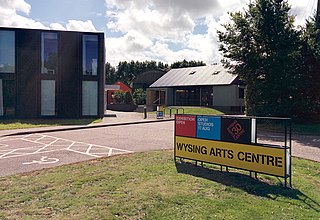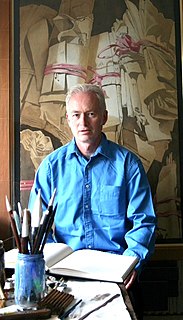Related Research Articles

David Hall was an English artist, whose pioneering work contributed much to establishing video as an art form.
Peter Kennard is a London-born and based photomontage artist and Professor of Political Art at the Royal College of Art. Seeking to reflect his involvement in the anti-Vietnam War movement, he turned from painting to photomontage to better address his political views. He is best known for the images he created for the Campaign for Nuclear Disarmament (CND) in the 1970s–80s including a détournement of John Constable's The Hay Wain called "Haywain with Cruise Missiles".
Ian Breakwell was a world-renowned British fine artist. He was a prolific artist who took a multi-media approach to his observation of society. Breakwell was born in Derby and studied at Derby College of Art, graduating in 1964.
John Aubrey Clarendon Latham, was a Northern Rhodesian-born British conceptual artist.
Trevor Bell was an English Leeds-born artist and contemporary visual artist.

Sir Alan Bowness CBE was a British art historian, art critic, and museum director. He was the director of the Tate Gallery between 1980 and 1988.
Fiona Banner aka The Vanity Press is a British artist, who was shortlisted for the Turner Prize in 2002. Her work encompasses sculpture, drawing, installation and text, and demonstrates a long-standing fascination with the emblem of fighter aircraft and their role within culture and especially as presented on film. She is well known for her early works in the form of 'wordscapes', written transcriptions of the frame-by-frame action in Hollywood war films, including Top Gun and Apocalypse Now. Her work has been exhibited in prominent international venues such as the Museum of Modern Art, New York and Hayward Gallery, London.
James Henry Cecil Collins MBE was an English painter and printmaker, originally associated with the Surrealist movement.
The Destruction in Art Symposium (DIAS) was a gathering of a diverse group of international artists, poets, and scientists to London, from 9–11 September 1966. Included in this number were representatives of the counter-cultural underground who were there to speak on the theme of destruction in art.

Spencer Frederick Gore was a British painter of landscapes, music-hall scenes and interiors, usually with single figures. He was the first president of the Camden Town Group, and was influenced by the Post-Impressionists.

Dexter Dalwood is a British artist based in London, England.
Lynette Yiadom-Boakye is a British painter and writer. She is best known for her portraits of imaginary subjects, or ones derived from found objects, who are painted in muted colours. Her work has contributed to the renaissance in painting the Black figure. Her paintings often are presented in solo exhibitions.

John Hoyland RA was a London-based British artist. He was one of the country's leading abstract painters.
Margaret Harrison is an English feminist and artist whose work uses a variety of media and subject matter.

Matt's Gallery is a contemporary art gallery currently situated in a temporary space at 92 Webster Road, London. Its director, Robin Klassnik OBE, opened the gallery in 1979 in his studio on Martello Street, before moving premises to Copperfield Road, Mile End in 1993. The gallery is named after Klassnik’s dog, Matt E. Mulsion.

The Borough Group was a collective of mid-20th-century artists from the Borough area of Southwark, South London. The group was associated with David Bomberg, who was then teaching a number of the artists that formed the group at the Borough Polytechnic, hence the name.

Wysing Arts Centre is a contemporary arts residency centre and campus for artistic production, experimentation and learning in South Cambridgeshire, England. The centre was established in 1989 and completed a £1.7 million capital development project in 2008. Across the eleven-acre site the centre holds ten buildings, including 24 low-cost artists' studios, a live-work space, specialist new media facilities, a large gallery, education facilities and a 17th-century grade II listed farmhouse which is used as accommodation for residencies and retreats. The main focus of the centre's activities is the international residency programme, but it also hosts temporary exhibitions, retreats, a programme for young artists, semi-permanent sculptural and architectural commissions and works on offsite projects with many other institutions nationally and internationally. It is a registered charity under English law.

Hugh Buchanan is a Scottish watercolour painter, renowned for his detailed draughtsmanship and treatment of light and shadows in interiors, and for a sense of depth and space that is reminiscent of the work of Cotman and Piranesi.
Lisa Le Feuvre is a curator, writer, editor and public speaker. In 2017 she was appointed the inaugural Executive Director of Holt/Smithson Foundation, an artist endowed foundation that aims to continue the creative and investigative legacies of the artists Nancy Holt and Robert Smithson.
Barbara Steveni was a British conceptual artist who was based in London. Steveni was the co-founder and director of the Artist Placement Group (APG), which ran from the 1960s to the 1990s. The APG's goal was to refocus art outside galleries and museums. It instead installed artists in industrial and government organizations to both learn about and to have a voice in these worlds and then, where possible, organize exhibitions of work related to those experiences. Its work was a key precursor of the now widely-applied artist in residency concept.
References
- ↑ "e-flux: Artist Placement Group, APG". 2012-02-14. Archived from the original on 2014-02-18. Retrieved 2014-02-01.CS1 maint: discouraged parameter (link)
- ↑ Williams, Gisela (2017-09-12). "Are Artists the New Interpreters of Scientific Innovation?". The New York Times. ISSN 0362-4331 . Retrieved 2019-05-22.
- 1 2 Naomi Hennig and Ulrike Jordan, ed. (2016). Context is Half the Work. Edinburgh: Summerhall.
- ↑ "APG: Artist Placement Group". Tate. Retrieved 3 December 2017.CS1 maint: discouraged parameter (link)
- ↑ "Organisation and Imagination (formerly APG, the Artist Placement Group)". /seconds. Peter Lewis. Retrieved 3 December 2017.CS1 maint: discouraged parameter (link)
- ↑ "Timeline". Artist Placement Group. Retrieved 3 December 2017.CS1 maint: discouraged parameter (link)
- ↑ "artist placement group". Tate. Retrieved 3 December 2017.CS1 maint: discouraged parameter (link)
- ↑ "Obituaries: John Latham". Guardian. Guardian News and Media Limited. Retrieved 3 December 2017.CS1 maint: discouraged parameter (link)
- ↑ "The Individual and the Organisation: Artist Placement Group 1966-79". Raven Row. Retrieved 3 December 2017.CS1 maint: discouraged parameter (link)
- ↑ Miller, Phil (25 July 2016). "Fringe show to tell untold story of radical 1970s artists explorations in industry by Artist Placement Group". Glasgow Herald. Retrieved 3 December 2017.CS1 maint: discouraged parameter (link)